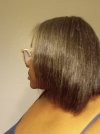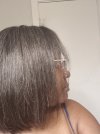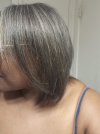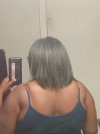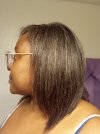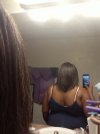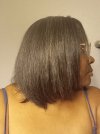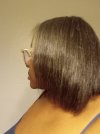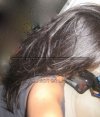Lylddlebit
Well-Known Member
See, you see it. It isn't just the heat itself, the tension used while drying has its own set of threats. The combination of blow dryer heat and overstretching during the process can cause coil/curl loosening. I know everyone's hair has different strengths and weaknesses, but speaking for myself, mechanical damage has always been a bigger threat to my hair than the regular use of high heat. I use high heat regulary and get pretty good reversion consistently. I wouldn't be bothered by heat damage so the idea of loosening coils don't bother me, I just rarely get that beyond the last few inches(that woudl get cut off soon) of very old ends. However, if I am rough with my hair that will cause me way more breakage and/or overstretching than my flat iron and hot combs ever do.So I read Saleemah's book. While most of what she said made sense in the scheme of things made, I was left with questions. Some of her ideas contradict cosmetic chemists, but most of it is neither here nor there. I just found it interesting that Saleemah felt blowdrying the hair alone was a way of heat training. The blowdrying method is to start once a month with blowdrying. Then you increase the blowdrying sessions to 2 times a month. I guess someone could even do once a week. This is suppose to be most gentle method of heat training and takes the longest to see results.The temperatures of most blowdryers don't go over 250F. Hair protein starts degrading depending on who you talk to somewhere after 350F to 375F. Since hair is a fiber and most fibers can be stretched out over time, I don't know if the blowdryer heat is directly what is breaking the disulfide bond for heat training. Pulling your hair back in a ponytail especially when wet too often can permanently stretch out curls. So not everything is heat related.
Saleemah even mentions not to use round-brushes too often because they will weaken the elasticity of the hair by constantly stretching the strands. I understand that hair is the weakest when wet. However, using the heat of a flat iron is traditionally considered more damaging to the internal structure of hair than the pulling of a round brush. The inside of a hair strand is where the elasticity lies. She says that having straight ends as a heat trained natural is perfectly fine if a person wears their hair straight all of the time. Are not those straight pieces the hair that has weakened elasticity? Round brushing and blowdryers are more likely to damage the cuticles and remove the lipid layer. If done properly, it will also eliminate the need to use a flat iron.
Then I started looking for journal articles on mechanical damage causing disulfide bonds to break before I said nuh-uh she is wrong. I found this one. https://www.sciencedirect.com/science/article/pii/S0006349522003289. This article is a little more technical than I wanted it to be. It seems as though if you go past a hair's tensile strength, hair will break no matter what. The sites at which the disulfide bonds break differ depending on if the hair is wet or dry. This only leaves me with more questions. Will a bond builder prevent the disulfide bond breakage or at least mitigate it? If so, will bond builders/peptide repair products stop or prevent the hair from even being heat trained with or elasticity lost from the mechanical use of tools?
What do you all think? Do you think the heat from blowdrying has the ability to heat train hair?
The tension that can be improperly applied while using the blow dryer can cause the curl/coil pattern to loosen, just like a ballon that has been filled up to the limit and then deflated.
Last edited:


 Well done, very smart way to make sure we click the link.
Well done, very smart way to make sure we click the link. 
 )
)


